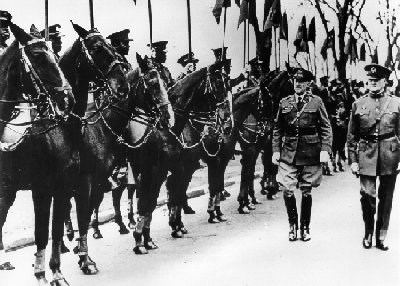|
The foremost military leader of his time, General John "Black Jack" Pershing (1860-1948) served in the Indian Wars, the Spanish-American War, the Philippines, the Mexican Intervention and World War I. When the United States entered World War I in 1917, Pershing was given the command of the American Expeditionary Force. This was not a good time for a war for the Army. There were limited supplies, no aircraft for an army still struggling with recruitment and organization. There was a diplomatic mountain to scale as well: the French and the British expected the Americans to serve under their commands. Pershing refused, and successfully demanded separate camps for his men as well as training by American officers and sergeants. In June 1918, the Germans launched a major offensive to capture crucial bridge crossings at the Marne River in France. Throughout the month, the American Expeditionary Force waged defensive and counteroffensive warfare against the Germans at the bloody Battle of Belleau Wood. In mid-July, the American Expeditionary Force was again tested at the Battle of Chateau-Thierry. Victories in both these engagements led to the end of the last major German offensive of the war. In September 1918, Pershing successfully led American and French forces in an offensive against the German line in the Saint-Mihiel salient. This victory proved the competency and quality of the American troops and was followed by the final offensive of the war, Meuse-Argonne. The slow, bloody advance of Allied troop progressed until November 11, 1918, when an armistice was finally declared. 
Golden Gate National Recreation Area, Park Archives Black Jack Pershing returned to the United States in 1919, where he was hailed as an American hero. He was promoted to a rank never attained before, General of the Armies, the highest American military rank. He served as Chief of Staff to the White House until the end of his military career. During this time, Pershing reorganized the Army. Among his achievements, Pershing updated military training techniques, emphasized physical fitness and started professional schools for officers. On September 12, 1924, after forty-two years of service, John J. Pershing retired from the Army. In retirement, Pershing continued to contribute to military life and was highly committed to his position on the American Battle Monuments Commission where he oversaw the construction of monuments honoring American soldiers who died in WWI. In 1931, he published his memoirs, My Experiences in the World War, which won the Pulitzer Prize. With the outbreak of World War II, General Perhing advised his old colleagues, generals George Marshall and George Patton. Pershing lived to see allied victory in 1945. On July 15, 1948. General Pershing was buried beneath a simple gravestone in Arlington National Cemetery near many of the men he led during World War I. Learn more about the General: John Pershing - The Early Years Resources Army Times. The Yanks Are Coming. (New York: G.P. Putnam's Sons, 1960). Goldhurst, Richard. "Pipe Clay and Drill, John J. Pershing: The Classic American Soldier," Readers Digest Press, 1977 Smythe, Donald. "Guerrilla Warrior: The Early Life of John J Pershing", Charles Scribner's Sons, 1973. |
Last updated: February 28, 2015
